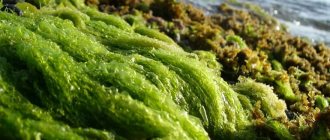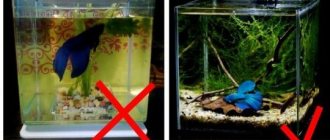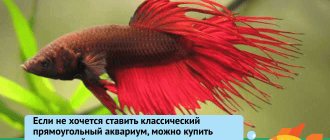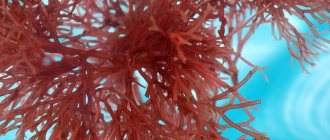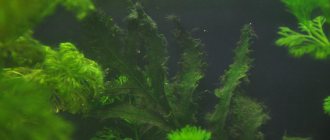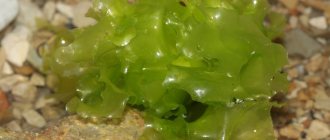ALGAE (Algae, or Phykos), a heterogeneous group of lower phototrophic organisms that live primarily. in reservoirs. Traditionally, they belonged to the plant kingdom, in which almost all divisions and classes of plants (green, red, brown, dinophytes, diatoms, euglena, etc.) were distinguished on the basis of the set of pigments present in the cells and morphological characteristics. signs. In modern systems based on ch. arr. Based on the criteria of the fine structure of cellular organelles, some sections of the V. are placed in independence. kingdoms, while in a number of them V. is combined with the department. groups of fungi and protozoa.
general characteristics
Algae are the most ancient and primitive plants, but at the same time they are distinguished by a variety of shapes and sizes. They can be multicellular or unicellular, microscopic and tens of meters long. Most of them live in bodies of water (both marine and fresh), but there are species of algae that have mastered life on land.
They vary greatly in shape and can be filamentous, bushy, branching, in the form of plates and balls.
Difference from higher plants
Algae have a more primitive structure than plants; among them there are many single-celled species. Their body (called a thallus or thallus) is not divided into organs, and they do not have leaves, stems or roots, although a number of species have parts of the body that look similar. They absorb nutrients through cell membranes. At the same time, the thalli contain plastids with chlorophylls, thanks to which they can carry out photosynthesis. Therefore, they are still classified as lower plants, and not separated into a separate kingdom. They should also not be confused with aquatic plants, which are not algae.
Edible seaweed
There are a huge number of edible algae representatives. For example, kelp, or seaweed, porphyry (aka nori), spirulina, sea lettuce. There are other varieties of edible seaweed, such as fucus, limu, rodeniya, and umi budo.
Distribution in nature and ecological groups of algae
Known approx. 50 thousand species of B. They inhabit all possible habitats and form many ecological systems. groups. In marine and continental reservoirs of all types, bacteria live in the water column, forming phytoplankton, in the zone of surface film (neuston), and at the bottom of reservoirs (phytobenthos); they settle on different soils, as well as on art. structures, ship bottoms (periphyton). The distribution of water in reservoirs is influenced by their hydrodynamic properties. features, illumination, temperature, presence of nutrients. Phytoplankton is dominated by single-celled bacteria: in fresh water bodies, green species; in seas, diatoms and dinophytes. Phytobenthos consists of attached bacteria that grow on hard and loose soils, on or inside plants and animals. In fresh water bodies, small forms predominate, penetrating to a depth of several meters. The phytobenthos of the seas makes up the majority. macrophytes - green, brown and red V., which inhabit the intertidal zone and the upper sections of the shelf to a depth of 40–50 m, with the exception of up to 200 m. In temperate and cold waters of the seas, large fucus and kelp V. dominate; in their thickets, species-rich, multi-tiered, highly productive communities are formed, the biomass of which can reach 40–100 kg per 1 m2 of bottom. As a result of eutrophication of the coastal zone of the seas and unsustainable fishing, large perennial species and associated hydrobionts disappear, and the structure of aquatic biocenoses becomes depleted and simplified.
OK. 2 thousand species of V. (mostly green) grow on the surface of the soil and in its thickness. Aerophilic V. live in the air under conditions of slight periodicity. moisture on a variety of substrates - bark and leaves of plants, rocks, wooden and stone structures, etc. They also develop in extreme conditions - in hot springs (diatoms), on snow (for example, Chlamydomonas snowy, which gives the snow a red color) , in ice (diatoms). There is a so-called drilling V., capable of penetrating into the calcareous substrate (microscopic green), and V., secreting lime (lithothamnium). V., living on other organisms, use them as a substrate, parasitize them or enter into symbiosis with them. The most interesting is the symbiosis of some V. with fungi, which led to the formation of new organisms - lichens, and with coral polyps, which, thanks to V.'s ability to photosynthesis, ensures the existence of a self-sustaining biological organism. coral reef systems.
Life cycle
They are capable of photosynthesis, as a result of which they obtain organic substances, although a number of species absorb ready-made organic substances from the external environment. As in higher plants, starch is used as a reserve substance, as well as glycogen (the latter is typical for animals).
Like plants, spores are capable of both sexual and asexual reproduction.
Reproduction
Algae have different methods of reproduction, the main ones being vegetative, asexual and sexual. Vegetative activity is carried out by cell division or reproduction of individual sections of the thallus. With asexuality, new spores are formed in the thallus, which germinate into new individuals. Spores are divided into zoospores (motile) and aplanospores (immobile). Finally, during sexual reproduction, sex cells are formed - gametes, after the fusion of which zygotes are formed, from which new individuals appear.
The structure of the thallus (thalom) of algae
In algae, there are several main types of thallus organization:
- I. Mononucleate unicellular organisms (or their colonies): Amoeboid
(rhizopodial). Single-celled organisms that lack a hard cell membrane and, as a result, are unable to maintain a constant body shape. Due to the absence of a cell wall and the presence of special intracellular structures, the cell is capable of crawling movement through pseudopodia or rhizopodia. Some species are characterized by the formation of multinucleated plasmodium by the fusion of several amoeboid cells. The amoeboid structure can secondarily acquire some monad forms by discarding or retracting flagella. - Monadic
.
Unicellular algae that have a constant body shape, a flagellum(s), often a stigma
, and freshwater algae have a contractile vacuole.
Cells actively move in a vegetative state. Often there is a union of several monadic cells into a colony, surrounded by common mucus, in some cases even connecting with each other through plasmodesmata
. Highly organized forms with a multicellular thallus often have dispersal stages - zoospores and gametes, which have a monadic structure. - Coccoid
.
Unicellular, devoid of any organelles of movement and maintaining a constant body shape in the vegetative state. Most often there is a thickened cell wall or shell; there may be various outgrowths, pores, etc. to facilitate soaring in the water column. Many algae with this structure tend to form colonies. Some diatoms and desmidiaceae
[?] are capable of active movement by secreting mucus [how?]. - Palmelloid
(capsular). A permanent, rather large, usually attached to the substrate, formation of several coccoid cells immersed in a general mucous mass. The cells do not unite directly with each other - there are no plasmodesmata. A temporary life cycle stage with a similar morphology is called the palmelle state. Many monadic and coccoid algae can enter this state upon the onset of unfavorable conditions; the resulting palmelle-like formations are usually small and do not have a permanent shape.
- Sarcinoid
. Colonies are groups (packs or thread-like formations) that arise as a result of the division of one parent cell and are enclosed in the stretchable membrane of that cell.
(non-cellular, siphonic). There are no cellular partitions, as a result of which the thallus, often large and externally differentiated, formally represents a single cell with a large number of nuclei [!].
. The thallus is represented by multinucleate cells connected into filamentous or other forms of multicellular thalli (Siphonocladales).
- Filamentous
(trichal). The cells are connected into a thread, simple or branched. The threads can float freely in the water column, attach to the substrate, or unite into a colony. Vegetatively filamentous algae usually reproduce by disintegrating the thread into separate fragments. Thread growth can occur in four ways: diffuse - all cells of the thread are divided, intercalary - the growth zone is located in the middle of the thread, apical - division of the terminal cells, and basal - cell division at the base of the thallus. The cells in the filament do not have flagella and can be connected to each other by plasmodesmata.
(heterotrichal). There are two systems of threads: horizontal ones creeping along the substrate and vertical ones extending from them. The horizontal filaments closely close together or can merge into a pseudoparenchymatous plate and perform mainly a supporting function and the function of vegetative reproduction, while the vertical filaments have a predominantly assimilatory function. Sometimes a reduction or excessive development of certain filaments can be observed, leading to a secondary loss or disruption of the characteristic features of the heterotrichous structure (with the reduction of vertical filaments, for example, the thallus can be a simple single-layer plate completely attached to the substrate.
(false tissue). It is represented by thalli that were formed as a result of the fusion of branched threads, often accompanied by morphofunctional differentiation of the resulting false tissues.
. Multicellular thalli in the form of plates of one, two or several layers of cells. They arise during the longitudinal division of the cells that make up the filament. The number of layers depends on the nature of the formation of partitions during cell division. Sometimes the layers can diverge, and the thallus then takes on a tubular shape (hollow inside), and the walls become single-layered.
(segmented-whorled). Characteristic only of charophyte algae. The thallus is large, multicellular, consisting of a main shoot with branches and sometimes branching, articulated lateral shoots. Lateral shoots depart from the main one in the area of the nodes; the part of the shoot between the nodes consists, as a rule, of one large cell and is called an internode.
In some blue-green, green and red algae, calcium compounds are deposited in the thallus, and it becomes hard. Algae have no roots and absorb the substances they need from the water over the entire surface. Large bottom algae have attachment organs - a sole (a flattened extension at the base) or rhizoids (branched outgrowths). Some algae have shoots that spread along the bottom and produce new thalli.
Classification of algae
The diversity of algae in nature is great; the names of algae (classes) depend mainly on color.
Green algae
The most numerous representatives of algae (the number of species is about 7 thousand). They are both unicellular and multicellular. They live mainly in the upper layers of reservoirs; in addition, single-celled plants can even live in puddles, snow and soil.
Brown algae
Ochrophyte algae, there are about 2 thousand species. Most live in the seas and only 6 species have adapted to life on land. They contain the pigment fucoxanthin, which gives them a brown color.
Red algae or purple algae
A small group of algae (about 200 species), mostly multicellular. They contain the pigment phycoetrin, which gives them a red color. They mainly live in the seas. They are considered one of the first, and arose back in the Cretaceous period.
Blue-green algae
They are also cyanobacteria or cyanides. The oldest of terrestrial organisms. They are found almost everywhere - seas or rivers, in hot climates and ice. They reproduce by division. Most of the phytoplankton consists of them; some types of algae enter into symbiosis with lichens. They have a bad reputation due to the toxicity of many types of water pollutants, dangerous to both fish and animals.
Symbiotic
Lichen
Algae that live in symbiosis with other organisms. They are not a separate group and symbiotes include plants of different species. Examples include the aforementioned lichen, consisting of fungi and algae; zooxanthellae living in symbiosis with coral polyps; green algae that settle inside ciliates. They can also carry out symbiosis even with higher vertebrates, for example, the yellow-spotted ambystoma, in whose body symbiotic algae settle, or the sloth, in which they live on the wool.
DIFFERENCES between mosses and ferns
1. Mosses have no roots. Ferns have many adventitious roots growing from the rhizome (modified shoot). 2. The leaves of mosses are microscopic, the leaves of ferns - fronds - have a complex structure.
3. In mosses, the gametophyte is an adult leafy plant; in ferns, it is a prothallus. 4. Mosses are haploid, ferns are diploid. 5. In mosses, photosynthesis proceeds slowly. Mosses can photosynthesize under snow. If the temperature of the cold season is close to 0, then the mosses remain evergreen. 6. Mosses are at an evolutionary dead end (impossibility of reproduction without water). 7. The body of mosses can be represented by a thallus (no organs), like in Liverworts.
8. Mosses have poorly differentiated tissues, while ferns have specialized tissues. 9. In mosses, spores are located in a capsule on a stalk, in ferns - on the back side of the frond (on the sporophyte). 10. The life cycle of mosses runs inextricably from the gametophyte and sporophyte.
In ferns, the sexual generation is a separate independent plant (thallus). 11. Some mosses can lead to swamping of their habitat.
—————————————— SIMILARITIES: these are departments of HIGHER SPOROUS plants.
Why do they appear in the aquarium?
Unlike aquatic plants, almost all types of algae in aquariums are undesirable and even harmful, in fact they are an analogue of garden weeds. They muddy the water, settle on the walls and destroy the plants on which they parasitize.
How to get rid of it?
There are various ways to control algae. Firstly, the aquarium can simply be cleaned manually, removing harmful plants and cleaning the walls and soil on which they have fallen, changing most of the water.
Secondly, you can use the inhabitants of the aquarium themselves. Among the fish, Siamese algae eaters, otocinclus and ancistrus catfishes, poecilliids, and a number of mollusks are well suited. The most suitable clams are theodocus clams and cardina multidentate shrimp, also known as amano shrimp. It should be borne in mind that they are needed in large quantities, otherwise they will not bring much benefit.
Finally, these are various drugs for controlling underwater weeds. Examples include Sidex, TetraAlguMin, Tetra Algetten, Tetra AlgoStop (from Algae - the Latin name for algae).
However, these drugs must be used extremely carefully and in dosage; some of them may not be safe for fish and plants.
Prevention
Algae love light, so you should reduce the lighting time and do not place the aquarium near windows. The light should not be too strong or weak - the first promotes the growth of green algae, and the second - brown algae. A large amount of organic residues also contributes to their reproduction, so the water must be regularly cleaned and changed, as well as selecting feed that leaves less organic residues and not overfeeding the fish. The temperature should not be too high - algae love it. It is also not recommended to use powerful filters that create a strong current in the water - red algae species like this. Long-stemmed plants like hornwort and elodea are good - if they grow quickly, they make it difficult for algae to feed. Just like with fish, it is important to monitor the feeding of plants - its excess also promotes their growth.
Mosses
Mosses are representatives of higher spore plants, along with ferns, horsetails and mosses.
None of the representatives of this group flowers or produces fruits or seeds. They reproduce asexually, producing spores, or sexually, but the process of fertilization is possible only in the presence of a moist environment.
The most common representatives of mosses are cuckoo flax, sphagnum, polythrix pilosa, brium, dikran and eriopus.
In the external structure of mosses, there is a difference between individuals of the sexual and asexual generation and individuals bearing male and female reproductive cells. Therefore, mosses are classified as dioecious plants.
Both female and male individuals have a stem that is densely covered with leaves. The upper leaves are traditionally bright green due to the presence of chlorophyll, the lower ones are usually yellow-brown due to the destruction of pigment in low light conditions. Mosses have no roots. They are attached to the ground by rhizoids, multicellular hair-like processes. Rhizoids anchor the plant in the soil and participate in the absorption of nutrients by the moss.
But the same nutrients can enter the plant through other organs.
On the tops of some mosses you can see long thin shoots, on top of which there is a box with a lid. These are individuals of the asexual generation that developed from a fertilized egg. Over time, they lose their green color and ability to photosynthesize, so they feed on individuals of the sexual generation.
The box with a lid, the sporangium, opens after the spores in it have matured. If the spores fall into very moist soil, they germinate in the form of a green thread, similar to filamentous algae. Such a “thread” grows, and from some of its cells individuals of the female and male sexual generation are formed. Despite the alternation of generations, the sexual generation predominates in the life cycle of mosses.
Mosses are considered the pioneers of terrestrial space; they are distributed in almost all natural land areas, as well as in shallow fresh water bodies.
Mosses regulate the water regime of soils, stimulating their waterlogging. Sphagnum moss is the main plant that forms peat, and is also one of the oldest dressing materials due to its bactericidal properties.
Application
Like higher plants, algae are also used as food and in medicine and cosmetology.
Cooking
Most edible algae belong to three groups - red, green and brown. They contain a large amount of proteins, vitamins and iodine, in addition, useful substances (such as agar-agar, alginic acid, carotenides) are obtained from them, which are used as food additives. Mostly seaweed dishes are used as food in Southeast Asian countries, especially in Japan.
Edible algae examples:
- kelp or seaweed – rich in iodine, stimulates metabolism;
- spirulina – rich in protein;
- Ulva or sea lettuce – contains a large amount of iron, protein and fiber;
- porphyry or nori - a traditional part of Japanese, Chinese and Korean dishes, useful for lowering cholesterol, a source of vitamins A, D and B12;
- lithothamnia – rich in vitamins, contains large amounts of magnesium and iron, useful for the prevention of anemia;
- ahnfeltia - used to produce agar-agar.
Also, there are various dishes using additives made from algae, for example, Japanese yokan marshmallow, with the addition of agar-agar.
Medicine
Algae are known primarily for their high iodine content, which fights viruses well and improves the synthesis of thyroid hormones. Since ancient times, they have been used to treat constipation, diarrhea, anemia, and thyroid dysfunction. Regular consumption of seaweed compensates for the lack of microelements such as fluorine, manganese, and iron. They also help remove heavy metal salts, radionuclides and other harmful substances from the body. Finally, they contain many vitamins.
Cosmetology
Algae are also actively used in cosmetology, mainly seaweed. Cosmetic preparations with algae provide skin care and nutrition, rejuvenate the skin and have an anti-inflammatory effect, and also improve the structure and appearance of hair and nails. Each group of algae has its own beneficial properties:
- green ones are rich in iron and antioxidants, improve microcirculation and metabolic processes;
- blue helps strengthen, tone and tighten the skin. Rich in amino acids and beta-carotene;
- brown ones contain a high amount of vitamins and minerals and are used to detoxify and moisturize the skin.
Question: which algae have rhizoids?
After the spore lands on a moist substrate, a thin, usually branched, green thread or plate of algae grows from it. This small thread (plate) is called protonema. After some time, buds appear on the protonema, giving rise to an adult moss plant. In true mosses, the stem (caulidium) and leaves (phyllidia) are clearly distinguished from each other; The stem is most often covered in the lower part with hairs or rhizoids.
At the tops of the main stems or lateral branches, reproductive organs develop: antheridia ♂ archegonia ♀, in which germ cells are formed. Sperm develop inside the antheridium, while the archegonium contains the egg. All stages of moss development, from the spore to the stem with leaves and reproductive organs, are combined into the concept of the sexual generation or gametophyte.
Fertilization of an egg by a sperm is accomplished with the help of drops of water inside the archegonium in damp weather; after fertilization, a capsule with a sporangium grows on the gametophyte, in which spores are formed after reduction division.
The box sits on a thin stem. This is a moss sporogon or asexual generation (sporophyte). By the time the spores ripen, the box opens at the top with a lid and the spores spill out.
Fern development cycle.
Sporophyte is the name of an adult leafy plant that forms significant thickets in temperate forests.
The sporophyte is the predominant generation of these plants. The next stage of the fern development cycle is the maturation of the organs of asexual reproduction. They are called sporangia. These structures look like small brown tubercles located on the underside of the leaves. On top they are additionally protected by filmy “covers”. Sporangia of ferns are collected in groups called sori. At the end of summer these structures darken.
This means that the sporangia are ripe. Then they open, and thousands of small cells spill into the ground. This is what controversy is about. If there is enough moisture, they immediately begin to germinate.
The result of spore development is a prothallus. This is the individual of the sexual generation, which is the next link in the development cycle of the fern.
Externally, it is a green, heart-shaped plate. The shoot develops on the soil, to which it is attached with the help of rhizoids. As the gametophyte develops, sexual reproductive organs are formed on its underside.
Two types of sex cells mature in them: eggs and sperm. Fertilization in ferns has its own characteristics. Firstly, male and female reproductive cells on the same germ mature at different times. Therefore, gamete fusion is possible only between different plants. This type of fertilization is called cross-fertilization. The second feature of this process in ferns is the obligatory presence of water. The fact is that the reproductive cells of spore plants cannot move independently.
Therefore, the sperm can reach the egg only with the help of water. Thus, although ferns belong to the group of the first land plants, they have not lost contact with their former habitat. Next, a plant of asexual generation develops from the fertilized egg, spores ripen on it, and the process repeats.
conclusions
- Mosses are more complexly organized than algae.
- Algae appeared much earlier than mosses.
- Among algae there is a large group of unicellular organisms, all mosses are multicellular organisms.
- Most algae live in an aquatic environment, most mosses live on land, but with a high percentage of humidity.
- The body of moss is differentiated into organs; only in the most developed algae can the prototype tissues be observed.
- Mosses have external differences between male and female individuals, between sexual and asexual generations.
In algae, all individuals of the same species are the same.
- Mosses cannot reproduce vegetatively, but algae can.
Red algae, or purple algae
They have all shades of red, as well as yellowish, olive and bluish-green colors. They contain many pigments, chlorophyll A and D, carotenes, xanthophylls, phycoerythrin and blue phycocyanite. Red algae are predominantly multicellular. The cells are mononuclear, the shell is pectin. The chromatophore is disk or plate-shaped, sometimes star-shaped. It looks like bushes.
You can distinguish stem and leaf organs on them. Dimensions reach several meters.
Algae are immobile because they are attached to the substrate. Habitat: sea, fresh water bodies, very rarely land. Sometimes propagation is vegetative. Asexual reproduction is zoosporous. The sexual process is oogamous.

